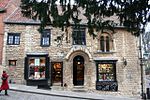Battle of Lincoln (1217)
1217 in EnglandBattles of the Barons' WarsConflicts in 1217History of Lincoln, EnglandMilitary history of Lincolnshire ... and 1 more
Use British English from May 2012

The Second Battle of Lincoln occurred at Lincoln Castle on Saturday 20 May 1217, during the First Barons' War, between the forces of the future Louis VIII of France and those of King Henry III of England. Louis's forces were attacked by a relief force under the command of William Marshal, 1st Earl of Pembroke. Thomas, Count of Perche, commanding the French troops, was killed and Louis was expelled from his base in the southeast of England. The looting that took place afterwards is known as the "Lincoln Fair". The citizens of Lincoln were loyal to Louis so Henry's forces sacked the city.
Excerpt from the Wikipedia article Battle of Lincoln (1217) (License: CC BY-SA 3.0, Authors, Images).Battle of Lincoln (1217)
Steep Hill, Lincoln New Boultham
Geographical coordinates (GPS) Address Nearby Places Show on map
Geographical coordinates (GPS)
| Latitude | Longitude |
|---|---|
| N 53.233333333333 ° | E -0.53861111111111 ° |
Address
Steep Hill 21-22
LN2 1LT Lincoln, New Boultham
England, United Kingdom
Open on Google Maps











